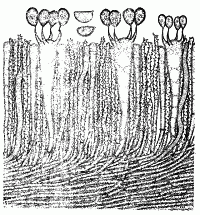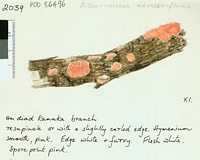|
 Aleurodiscus ochraceoflavus Aleurodiscus ochraceoflavus
BiostatusPresent in region - Indigenous. Endemic
Images (click to enlarge)
Caption: Fig. 1. - Aleurodiscus ochraceo-flavus. | 
Caption: FIG. 5. Aleurodiscus ochraceo-flavus. Transverse section showing gloeocystidia and
acanthophyses, x 550. | 
Caption: Watercolour
Owner: G.M. Taylor |
Article: Cunningham, G.H. (1956). Thelephoraceae of New Zealand. Part XI. The genus Aleurodiscus. Transactions of the Royal Society of New Zealand 84(2): 237-268.
Description: Hymenophore annual, coriaceous, pezizoid, orbicular with margins free and attached by a
narrow base, 2-7 mm diameter, often laterally confluent, forming linear areas to 2.5 cm in
length; exterior surface white, tomentose, margins inturned, acute, entire or lobed; hymenial
surface slightly concave, pruinose, even or dimpled in large specimens, flesh colour, not
creviced. Context white, to 0.5 mm thick, composed of compacted hyphae radiately arranged,
with embedded crystals at the base of the subhymenium; tomentum of two types (1) long,
cylindrical and unbranched. covered with densely arranged spines; (2) angled hyphae bearing
hooked spines near the bends; generative hyphae to 6 µ diameter, walls 0.5-1.5 µ thick,
hyaline, branched, septate, with clamp connexions. Hymenial layer to 190 µ deep, a dense
palisade of basidia, paraphyses, acanthophyses and gloeocystidia. Basidia clavate, projecting
slightly, 110-160 x 16-22 µ, 4-spored; sterigmata arcuate, subulate, to 16 µ long. Paraphyses
subclavate, to 100 x 10 µ. Acanthophyses arising in the base of the subhymenium and
traversing the hymenium, cylindrical, to 8 µ diameter, covered throughout with lateral blunt
spines 2-4 µ long. Gloeocystidia arising in the base of the subhymenium and traversing the
hymenium to different levels, flexuous-cylindrical, 60-250 x 7-12 µ, walls 0.5 µ thick. Spores
obovate, elliptical with one side slightly flattened, or a few D-shaped, 18-20 x 12-15 µ, walls
finely verruculose-aculeate, hyaline, 0.5 µ thick, amyloid.
Habitat: HABITAT. Scattered or confluent on bark of dead branches and stems.
Distribution: TYPE LOCALITY. York Bay, Wellington, New Zealand.
DISTRIBUTION. New Zealand.
Notes: Fructifications are pezizoid, rarely cupulate, and attached by a narrow base with margins free.
The hymenial layer is deep, and densely compacted. Acanthophyses are abundant, cylindrical,
and covered throughout with bluntly pointed lateral spines. In the surface tomentum there are
present both this type of acanthophyses and angled branched hyphae bearing long, acuminate,
often hooked spines. Spores are for the most part obovate or elliptical with a basal apiculus,
though a few detached spores were seen to be D-shaped. They are smaller than those of A.
mirabilis and A. zealandicus. The species appears to be confined to two species of
Leptospermum.
Lloyd's description of the type is faulty in most particulars. Pilei are pezizoid, not resupinate;
the hymenial surface is flesh-pink, not ochraceous; there are no filiform paraphyses, and
acanthophyses are crowded, not rare; spores are not compressed-globose and smooth, but
obovate or elliptical and verruculose-aculeate.
Three species. A. mirabilis, A. ochraceo-flavus and A. zealandicus, show a close resemblance to one another. Fructifications are pezizoid, tomentose at margins witlh branched spinose
hairs and acanthophyses, basidia are similar in size and shape, spores are verruculose-aculeate, and acanthophyses cylindrical and spinose. Separation may be made upon the
differences in spores, acanthophyses and tomentum. Acanthophyses are spinose on the upper
third in A. zealandicus, throughout their length in A. ochraceo-flavus, and of two types in A.
mirabilis. Spores are commonly D-shaped or citriform in A. mirabilis and A. zealandicus,
obovate or elliptical in A. ochraceo-flavus, coarsely aculeate in A. zealandicus and finely
verruculose-aculeate in A. mirabilis and A. ochraceo-flavus.
|